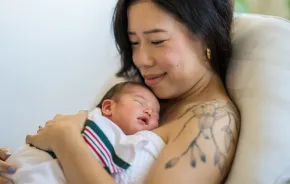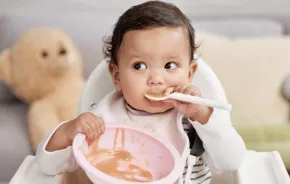She will enter her first year as a helpless newborn and leave it as a
babbling toddler, in confident command of the world around her. In the
months between, your baby will undertake a series of transformations
that can truly be described as miraculous.
Use these milestones as a guide to what changes to expect during your
baby's first year of life. But remember that every baby develops at a
different pace, and a perfectly healthy child may achieve a particular
milestone later than average.
Kathryn Barnard, R.N., Ph.D., director of the Center on Infant Mental
Health and Development at the University of Washington, underscores
this, saying "Except for extreme delays, the age at which your baby
achieves these developmental milestones has little or no impact on how
he will turn out."
1 month
Your newborn spends most of his first weeks eating, sleeping and gazing
at his new environment. Most of his movements are reflexes that will
disappear over the coming weeks and months. These include "rooting" for
the nipple that provides his food, throwing his arms out and back
together when startled, and marching his legs when held in a standing
position.
His kicks and thrusts will at first be very jerky, but as his nervous
system matures and he gains muscle control, they'll become much
smoother and stronger. And though his hands remain mostly in tight
fists, he will now be able to bring them to his mouth.
Your baby's vision undergoes important changes in the first month of
life. He'll learn to track objects briefly, and though he sees best
from a distance of 8 to 12 inches, he may be able to focus briefly on
things as far away as 3 feet. He's getting better at seeing and
recognizing patterns and is particularly drawn to those that are high
contrast. His favorite pattern to study is the human face, so keep
yours close as often as possible.
Your baby hears very well at one month and will pay close attention to
human voices. When you talk to him, he'll likely turn his head to
search for your voice.
2 and 3 months
Your baby's muscle strength is increasing, and by the end of her third
month she will be able to hold her head and chest up while supporting
herself on her elbows. Her kicks will be stronger too, and by the end
of month three she might have managed to kick herself over, probably
from front to back. (Many babies won't roll the opposite direction
until about month six).
She is fascinated by her hands and what they can now accomplish. By the
end of this period, she can probably open and shut them, bring them to
her mouth, swipe at dangling objects, and shake a rattle.
Around the 6- or 8-week mark, a huge event occurs for you and your
baby: her first genuine smile. Soon your baby will begin squealing in
delight and trying to imitate the sounds and facial expressions you
make. You may even hear the beginnings of babbling!
4 and 5 months
Your baby can now lift his upper body, supporting himself on his hands.
If it didn't happen last month, this will almost certainly be the time
when practice pays off and he rolls himself over.
During the fifth month, your baby will likely acquire the strength to
keep his head level with his body (rather than flopping backward) when
he's pulled into a sitting position. Once sitting, he can keep himself
upright, although he will probably still need to lean on his hands or a
pillow for support. From a sitting position, he will reach for
interesting objects and use his hands and mouth to explore their size,
shape and texture.
6 and 7 months
Your baby can now sit without support, leaving her hands free to reach
for and grab everything in sight. With her improved hand coordination,
she can now transfer toys from one palm to the other, twist them and
turn them from side to side.
She is also making some important cognitive leaps. She may respond to
her own name now, as well as the word "no." She's actively
experimenting with cause and effect, shaking rattles to hear the noises
they make and dropping things to watch them fall.
Another major new discovery is object permanence, the concept that
people and things still exist when they're out of sight. Now if you
remove a toy your baby was playing with, she may protest or even search
for it.
8 and 9 months
Your baby now gets up on his hands and knees. Once there, he may only
rock back and forth or push backward, but sometime between 7 and 10
months, he will probably master the crawl. Fine motor control is also
improving, and he can now pick up very small objects using his thumb
and forefinger in a "pincer grasp."
He pays increasing attention to speech and now comprehends a whole lot
more than you likely suspect. Though he probably has no actual words in
his vocabulary, the coos and gurgles of his earlier months are giving
way to recognizable syllables like "ba," "da," "ma" and "ga."
Now that your baby understands you're still somewhere even when you're
out of sight, he may react with distress and clinginess when you leave.
As Dr. Barnard puts it, "The baby has learned that when you are there
she will be all right, so it is natural to feel less secure when you
are not around." This is the beginning of separation anxiety, and it's
healthy and normal in babies of this age, usually fading in the last
half of their second year. New fears of strangers, the dark and loud
appliances are also common.
10-12 months
Your once stationary little newborn is now pulling up to standing,
"cruising" along the furniture and dancing to her favorite music. Many
children take their first solo steps around their first birthday,
although it's normal to walk months earlier or later.
Your baby loves testing your responses to her actions -- for instance,
dropping food from her high chair to see how you react. She knows
things have names and functions and is beginning to use objects
correctly. You'll want the video camera ready when she first attempts
to run a brush through her hair or hold the phone to her ear.
She's increasingly communicative and may now shake her head "no," clap,
wave "bye-bye" and stretch out her arms to be picked up. She also
babbles with conversational inflection, tries to imitate words and may
even say a few specific words, such as "mama" and "dada."
She's also developing her independence, and don't be surprised if you
see a new stubborn streak emerging. Says Dr. Barnard, "Realizing she
can do things herself is a great thing. Independence helps children
discover they are competent and don't always need your assistance."
Building skills and having fun
Your baby will enjoy different objects and activities as he changes
month to month. Here are some ways to have fun while nurturing his
mental and physical development.
1 month
Lots of cuddling and swaddling will help your baby feel safe and
secure. Talk to him often, even if you're just recounting the mundane
rituals of the day, and address him by name. The high-pitched,
exaggerated "baby talk" you probably use intuitively is perfect for
capturing his attention. To nurture his visual development, show him
simple objects or patterns in bright colors or black and white.
2 and 3 months
Give baby time on her tummy each day, but expect that she'll only last
a short while before getting tired. "Gyms" with dangling objects will
fascinate her and might even give you a few moments to yourself. Play
music and sing to her -- whatever the quality of your singing voice,
she is sure to adore it.
4 and 5 months
Give baby lots of opportunities to practice sitting, putting tempting
objects within arms' reach. But be sure to keep cushions around in case
he loses balance. Diaper changes can be great opportunities for quality
time, but beware of the roller your baby is becoming and never leave
him unattended on the changing table. It's also more important than
ever to make sure no choking hazards are within reach, including
removable small parts of toys.
6 and 7 months
Introduce your baby to new sights and sounds and name each one aloud
for her. Read to her and let her stroke the fuzzy sheep and push the
squeaky ball. But don't be surprised if you rarely make it to the last
page before the book ends up in her mouth or tossed aside.
Mirrors are a source of endless fascination for babies of this age,
though they won't begin to recognize themselves for another couple of
months. Hiding games and peek-a-boo are interactive and fun and help
reinforce the concept of object permanence.
8 and 9 months
By now you've probably discovered that your baby will pass over all the
fabulous toys in his possession in favor of the most mundane household
objects. Plastic containers, pots and cooking utensils make great
playthings, and your baby will love rooting through cabinets and
removing and replacing the contents of drawers. Baby-proofing your home
is essential now if you haven't undertaken it already. To encourage
crawling, try placing tempting objects just out of baby's reach.
Encourage his fine motor skills by giving him cereal and other safe
finger foods. He may also enjoy practicing self-feeding with a fork and
spoon.
10-12 months
Sturdy wagons or push cars are great for practicing walking. Blocks and
cups to stack and knock down, as well as toys with moving parts, will
help baby test her ability to make things happen. Stimulate her
communication skills by giving her opportunities to converse. Ask
questions and wait for her to answer; respond to her babbling as though
she were speaking (she is, in her own way). Give her opportunities to
feel independent, like turning the pages of her book or trying to put
the lid on her lunch container. It takes patience on your part, but it
will pay off in the happiness and sense of accomplishment it gives her.
Allison Dworkin is a freelance writer/editor living in Seattle with two daughters, ages 4 1/2 and 2.









